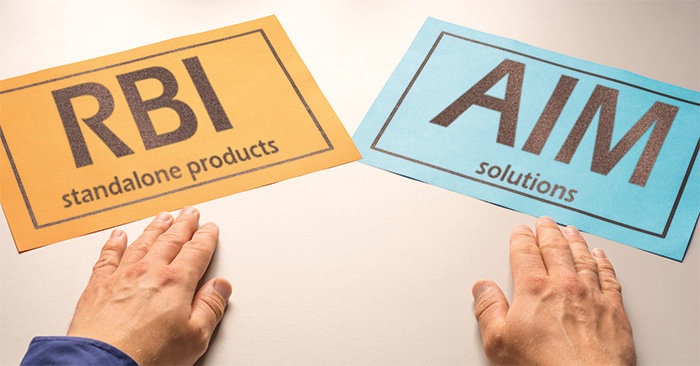Comparing Standalone RBI Products with Asset Integrity Management Solutions
Standalone RBI vs. a Comprehensive AIM program – Which to choose?
Posted on | by Dave Maguire, Senior Advisor – Asset Integrity – Metegrity | Category: RBI, Asset Integrity Management, Risk Based Inspection

Risk Based Inspection (RBI). A pillar in modern asset integrity technology, its benefits have become widely known and accepted (we examined all of the ways RBI reduces shutdowns and improves profitability in previous articles, here and here). The intelligent risk analysis afforded in comparing an asset’s unique probability of failure (PoF) vs. its consequence of failure (CoF) allows operators to reliably extend inspection intervals. In fact, RBI has been shown to reduce inspection points by as much as 80%, and cut down the likelihood of unplanned shutdowns by more than half.
RBI has gained immense popularity in recent years, leading to the emergence of numerous RBI products with varying scopes, functions, and designs. For owner operators who are new to the RBI landscape, choosing the right product can be overwhelming. In fact, even for those who have been utilizing RBI in some capacity for quite awhile, the expanded plethora of RBI products poses new questions: How does my product stack up? Is it sufficient? Has the technology evolved beyond what I’m using?
The onset of “standalone RBI” products evokes even further questioning. What exactly is a standalone, and how does it differ from an Asset Integrity Management (AIM) program?
A standalone RBI product refers to a software tool that exists solely for the purposes of RBI analysis and assessments. This differs from an AIM software, which will have all the same RBI functionality in addition to dozens of comprehensive modules for the full analysis, assessment and integrity management of static and rotating equipment. Although some standalone products might go so far as to include modules for static data, inspection results, inspection planning and scheduling, these modules are far less featured than the comprehensive modules available in a full AIM software.
At first glance, an RBI standalone product can seem to have value. It would typically feature some of the key functionalities, including:
- Repository of completed equipment RBI assessments
- Detailed graphs showing assessment results
- Equipment scheduling data
- Inspection history and plans
- TML readings
- API quantitative RBI software with “What If” case analysis
- An available connector to allow data import and export from a full AIM software
- Report summaries
On paper, these features look great. In terms of utilizing RBI, the above functionality would be part of the ideal parcel to look for. To top it all off, the product itself is dedicated to RBI only. Therefore, it must be the best option if you are looking to incorporate risk-based analysis into your asset management. Right?
Not so fast.
While the features included in a standalone software can be fantastic, they end there. The user is “making do” with a software that only provides a detailed asset summary, thus providing a high-level view of the equipment being managed. It would not be suitable for comprehensive asset integrity management of all assets, which would lead to the organization making two purchases: one for RBI, and one for the rest of the AIM. In fact, that’s likely why many of these standalone products include connectors to a third-party AIM software to begin with. It certainly wouldn’t be suitable for a large inspection group, where detailed and complex activities are being managed by individuals with varied security levels.
A potential concern with some of these products is a lack of transparency. Some tend to provide only the final results of an assessment, with no indication as to how the Risk Level was determined. They retain the data and if risk re-evaluation is required, the client must pay again. (Comparatively, with an AIM software, the client retains ownership of all data, can clearly see how the risk was arrived at, and can perform a re-assessment themselves at any time free of an additional fee).
Due to the limited features, users may need to keep inspection data, especially TML trending data, on spreadsheets, which would then average or calculate readings for transfer to the RBI software.
The Better Value: AIM with Built-In RBI
Compare these factors with a comprehensive AIM software that includes a dedicated RBI module. First, all the same functionality is already included in the AIM software (but on a much more comprehensive and detailed level), as well as additional functionality significantly beyond the scope of the standalone option. This allows for more detailed assessment (as opposed to just high level) and transparent arrival of risk levels.
The full AIM software includes much more flexibility and allows for more detailed actions, which are employed during the full asset work cycle. Those benefits include:
- Dozens more additional available supporting modules
- More robust scheduling features
- More detailed and varied reports
- Dashboards
- Fully featured index
- Excel wizard data import/export functions
- More comprehensive and detailed inspection reports, TML trending
- Data logger interface and quarantine review
- Integrity Operating Windows
- Corrosion Control Documents
- Data in one location
- Ability to keep integrity data current
- Reassessment of RBI and changing risk results applied immediately with updated schedules for equipment and TMLs
It's important to consider the value of investing in an AIM program with RBI built in versus a standalone RBI product. An AIM program can deliver everything a standalone product can and much more.
Why, then, might someone choose a standalone software in the first place? Some owners may mistakenly believe that the RBI software is all that they need, causing reluctance to invest in anything further. Others may be using outdated AIM software that does not include an integrated RBI, unaware that a single program can do both or daunted by the perceived expense of such an upgrade. It's important to recognize that cost should not be a deterrent in this decision.
In fact, it's more cost effective to choose an AIM program with RBI built in from the beginning. The cost of implementing or upgrading to better AIM software with RBI will only increase over time as more data is collected. Additionally, having two separate software programs creates information silos and increases IT management costs for upgrades and maintenance. Therefore, it's wise to make the switch to an AIM program with RBI built in early on to save on costs and streamline operations.
Contact us today to learn more about our comprehensive software solutions and start streamlining your asset management operations.
Related Information
About the author
 Dave Maguire, Senior Advisor – Asset Integrity – Metegrity has spent over 10 years implementing the Visions Asset Integrity Management (AIM) software and instructing/supporting clients with AIM and inspection systems. He worked with Shell Canada for 30 years in inspection, corrosion, major projects and process operations. He is a long-time member of NACE, the National Association of Corrosion Engineers.
Dave Maguire, Senior Advisor – Asset Integrity – Metegrity has spent over 10 years implementing the Visions Asset Integrity Management (AIM) software and instructing/supporting clients with AIM and inspection systems. He worked with Shell Canada for 30 years in inspection, corrosion, major projects and process operations. He is a long-time member of NACE, the National Association of Corrosion Engineers.
Press Releases
- 21 April 2021
Metegrity congratulates Mr. Suresh S. Bheema as a Subject Matter Expert at RBI 2021 4th International Conference - 06 October 2020
Metegrity Confirms New CEO, Martin Fingerhut - 17 September 2020
Metegrity Appoints Suresh Bheema as Senior Vice President - Asia Pacific Region - 17 December 2019
Visions Enterprise® 5 Achieves SAP-Certified Integration with SAP S 4HANA® - 19 November 2019
Metegrity Appoints New Chief Operating Officer, Martin Fingerhut
Latest Posts
- 22 January 2020
Metegrity CEO Discusses Petrochemical Cybersecurity at the 2019 G7 Summit - 30 September 2019
Join Metegrity at the 2019 OpEx Summit in Houston - 23 July 2019
The 13th Annual Maintenance & Reliability Symposium - 07 May 2019
Operational Excellence in Energy, Chemicals & Resources Summit 2019 - 05 March 2019
PMIES Expo 2019